What is Incentive Marketing? [Complete Guide with Examples]
What is the best way to lure in a new customer?
Obviously, offering them what they want the most. However, if you give it to them for free, you could end up with not just an average new buyer but a loyal client that keeps returning to you year after year.
This strategy is also known as incentive marketing, and it’s the topic of our guide today. We’re going to cover the importance of creating incentives, their types, and how to introduce them to your campaigns the right way.
Let’s dive in.
What is Incentive Marketing?
Incentive marketing is a strategy involving motivational tactics such as rewards programs, competitions, gift cards, vouchers, and other “incentives” to promote a product or service.
Let’s explain this approach in simpler words. Imagine you’re scrolling through Instagram (or other social media) Feed and see your favorite brand organizing a giveaway, but the participants are required to submit UGC content/leave a comment mentioning three of their friends/follow the account, etc. You do as the brand asks, it selects you among several winners, and you get a reward.
Thus, the bottom line of incentive marketing is the following: brands ask you to perform an action and then give you something for it. With the definition clear, let’s see why this tactic deserves a place in your digital marketing strategy.
Why is Incentive Marketing Important?
What is the purpose of incentives?
Think about it. People love free stuff, and when they win something, even if it’s not that substantial, it brings them joy. Science links this reaction to dopamine, the hormone in our brain responsible for the feeling of pleasure. Naturally, if you create a situation for someone where they can potentially experience that dopamine rush, they will do (almost) everything you ask.
Alright, enough with the science; let’s take a look at more marketing-related reasons why you should use incentive marketing:
- Increased brand awareness. Rewarding a consumer with a gift is a surefire way to build an instant connection with them. So, next time when they are in need of a product similar to yours, they will think of your brand name.
- Improved lead generation. When a consumer gets a product as a reward from a brand and likes it, the chances are high that they will return to buy it again. Statistics confirm that incentives boost customer acquisition – 69% of consumers say they are more likely to try a brand that gives out rewards.
- Better relationships with customers. Incentive marketing boosts customer loyalty – 60% of consumers confirm it saying unexpected rewards are the primary reason why they stay devoted to a brand.
Here, it’s also worth noting that all the above-mentioned benefits combined result in one significant advantage – more profit. Incentive marketing improves customer retention by 5%, which results in a 25% increase in revenue and better customer satisfaction. Moreover, if we talk about brand loyalty, loyal clients spend 67% more on a business they know than on new ones.
So, we can come to the conclusion that incentive marketing is well worth your time. Now, let’s talk about different types of incentive marketing along with some examples.
5 Key Types of Marketing Incentives
Essentially, anything that requires a person’s action and rewards it with a product can be called an incentive. However, if you’re only considering introducing this marketing approach to your branding strategy and don’t know where to start, let us show you the five key types of marketing incentives you can employ.
Type #1: Referral rewards programs
Referral rewards programs are a part of referral marketing aiming to encourage existing customers to recommend a brand’s products or services to their family, friends, or acquaintances. When a referrer brings their friend as a new customer, they get a reward. Sometimes, this new customer can get some perks (like a subscription discount) as well. This incentive also belongs to word-of-mouth marketing.
Airbnb’s referral program is a good example where both a referrer and their friend get something in return. As a member of the incentive program, you earn promotional coupon credits (i.e., Travel Credits) for referring new customers, which you can later spend on booking a stay. Referred clients also get coupons when they book a stay via a valid referral link. So, it’s a triple win for the brand, the customer, and the new client.
Type #2: Loyalty programs
A loyalty program is a strategy aiming to encourage existing customers to keep buying products or services from a brand. In exchange, they get discounts, promotions, and other goodies.
To help you understand how these incentive programs work, let’s look at Holo Taco’s Loyal-Tea Rewards. Essentially, you get loyalty points for each nail polish or other product purchased from Holo Taco, and reaching a certain number of these points opens a new tier with its own perks:
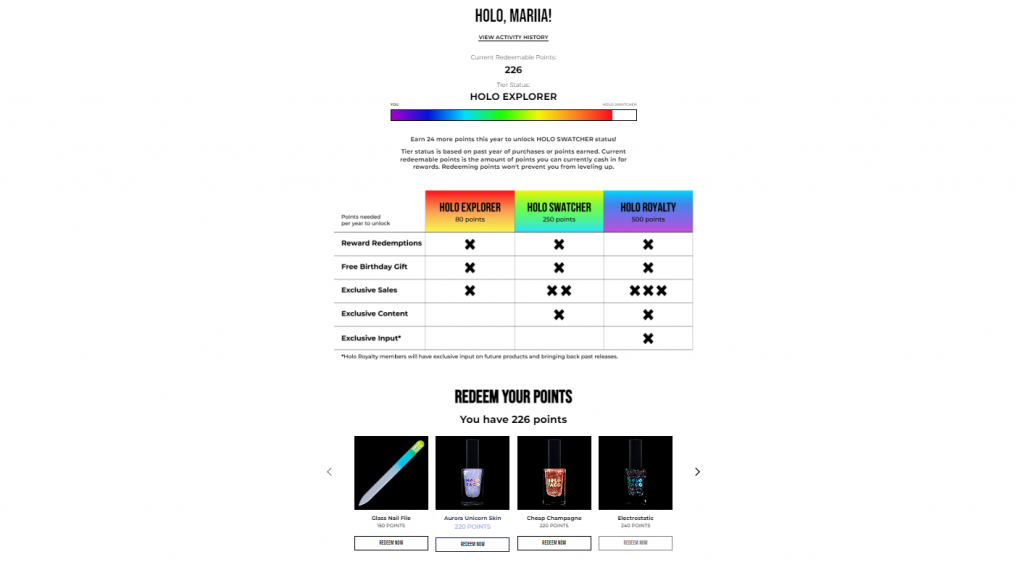
You can spend your points (redeem them) on other Holo Taco products and also get a gift on your birthday.
According to the Incentive Marketing Association (IMA), loyalty programs are pretty profitable and can achieve the ROI of 2:1 to 4:1. That is possible of course if you track all the proper metrics that measure the success of your program.
Type #3: Early access programs
An early access program is a type of incentive marketing that gives select customers priority in getting access to a new product or service. These can be your returning customers, new subscribers you want to nurture, or everyone based on the “first come, first serve” basis.
Check out this example of an early access program from Aero, an airline company owning semi-private jets. In the email below, Aero invites its subscribers to be among the first to book a flight to Napa Valley, their new destination:
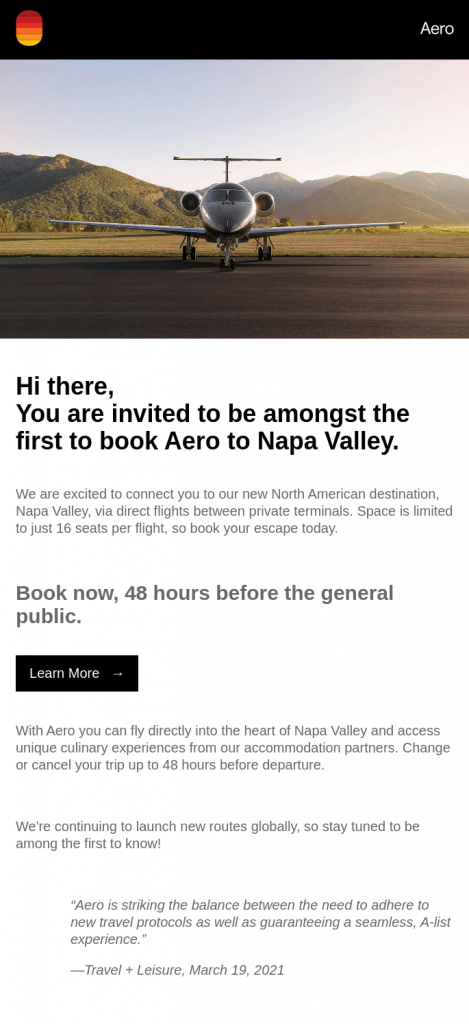
The brand offers a select few customers to book a flight 48 hours before the general public, with free cancellation or ticket change two days before the departure date. Aside from boosting customer engagement and increasing sales, an early access program also helps you understand the level of interest in your product or service.
Type #4: Price reductions
A regular product discount is also a great incentive, especially for your existing customers. You can reduce prices for a specific product category or go all out with a total sale (common among e-commerce brands before major holidays).
Some businesses have ongoing discounts on their products. For instance, H&M has a regular section on its website containing products with a price reduction of up to 70% off. These are usually clothes from previous collections:
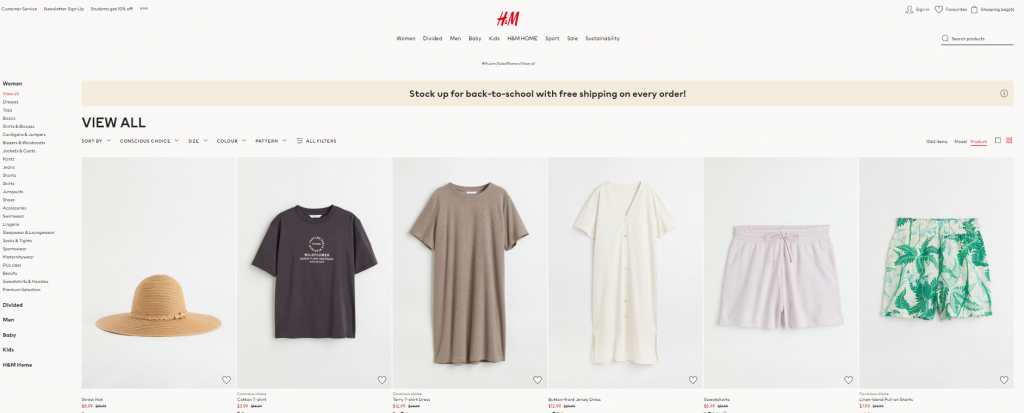
Aside from simple price reductions, you can also offer coupons or free shipping for a selected group of products.
Type #5: BOGO (Buy one get one)
BOGO, or buy one get one, is a promotional technique where a seller offers a consumer an additional product as a reward for making a purchase. For instance, you may buy a blanket and get a pillow as a gift.
However, this strategy is not limited to only two products (one purchased, one rewarded). Bath & Body Works, for example, offers a Buy 3, Get 3 Free program for a limited number of self-care products:
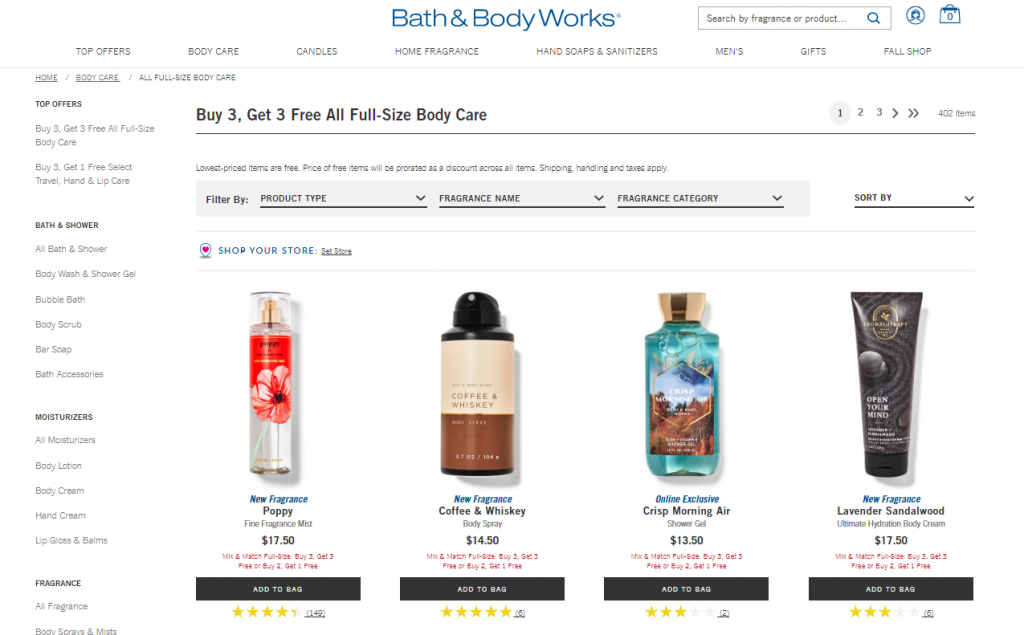
The brand also made this promo limited in time to further incentivize consumers to make a purchase.
As you can see, there are quite a few ways you can implement incentive marketing to get your brand noticed, increase conversions, and boost sales. Now, let’s take a look at more options to integrate this strategy into your campaigns.
Incentive Marketing Ideas to Implement in Your Campaigns
While incentive marketing programs and continued price reductions are mostly standalone strategies, there are some other tactics you can implement in your marketing plan. Their task is to upsell or simply give a consumer a push towards purchasing your products.
- Free shipping. Offering to ship products for free can be an effective strategy to increase conversion rates. After all, shipping fees are often named as one of the reasons for cart abandonment. However, this tactic should not be year-round and will depend on the nature of your business and profit margin.
- Premium memberships. This tactic means that a portion of your customers will get access to more features than your standard membership offers. They will have to pay extra, of course, but the value of additional features should overshadow the price for the premium membership. By the way, your sales team can also give loyal customers a discount on a premium subscription to encourage them to stay with you.
- Free samples. Here, you give free products to potential customers. This strategy is especially effective in the Food & Drink and Health & Beauty industries. To understand what it is about, think of the last time you ordered your skincare products and got a sample of a moisturizer as a gift.
- Bundles. This tactic implies a group of branded products under one stock-keeping unit or package. The goal is to cross-sell and boost revenue and ROI of goods that don’t sell that well.
- Sweepstakes (a.k.a. giveaways). Here, a brand gives prizes to the participants who have performed a certain free-of-charge action. You can include this strategy at the beginning of your campaign to boost engagement and brand awareness.
All these incentive marketing strategies look great, but how can you make them work even better and bring more tangible results?
Let’s take a look.
3 Tips for a Better Incentive Marketing Strategy
Although incentive marketing seems like something pretty straightforward, it absolutely can be done wrong. People do like free stuff, but if they have to go through hell and high water to get it, you shouldn’t expect the same level of excitement.
So, here are three tips we encourage you to follow if you want your incentive strategy to work.
Tip #1: Keep the incentive simple
As we mentioned, people are unlikely to want to partake in something overly complicated, even if it gets them a cool prize in the end. Thus, when sharing your marketing incentive with your target audience, make sure the idea behind it is as clear as day to them.
Suppose you want to try the BOGO tactic. Explain the idea of the incentive through one declarative sentence, such as “Buy one moisturizer, get the second one for free” – keep the message as simple and straightforward as possible if you want maximum engagement.
Tip #2: Keep your incentives business-relevant
Don’t rush with a product choice for the promotion. Instead, try to think about how your offer can benefit your business before including it in your incentive plan. For instance, by putting together the most and least popular products in a bundle, you can increase sales and lower marketing and distribution costs.
However, don’t forget about your target audience, too – special offers in your incentives should correspond to their needs and interests.
Tip #3: Clearly communicate the action and benefits
Similar to keeping the incentive simple, you should also clarify the action required from the prospect and its benefits in the most straightforward way.
Overall, try not to make the rules too demanding. For instance, contests have an average of 10 fields in participation forms that contestants should fill in. You can make it even less, considering that most participants would not enjoy spending more than five minutes on this activity.
You shouldn’t underestimate the importance of content used for incentive marketing, too. After all, it is the primary factor impacting the engagement rates. We recommend using interactive content here – it performs well in terms of conversions and is great for brand awareness.
Finally, let’s look at some more examples of incentive marketing in action.
3 Great Incentive Marketing Examples to Inspire You
We’ve already shared some of the best incentive marketing examples, but below, we have a few unique instances from major brands that you can take as inspiration for your next campaign.
Example #1: Amazon Prime
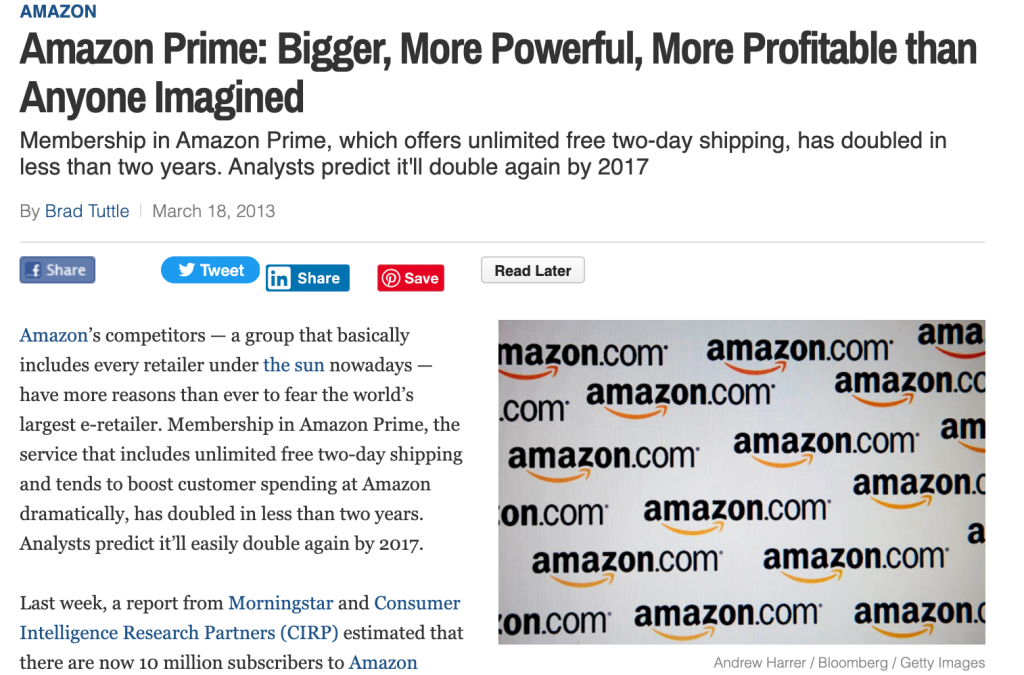
With most retailers and e-commerce companies, a customer gets a discount or a reward for a purchase. Amazon took a different path – with its Amazon Prime program, you get rewards after you buy.
Sounds weird?
Well, it actually makes a lot of sense if you consider all the perks this program provides. If you’re a member, you can get unlimited two-day free shipping on every order, early access to Amazon Lightning offers, almost a million free ebooks and videos, etc. The program is a huge success – Amazon Prime customers reportedly start spending 150% more after signing up for it. The reason is simple – this program makes deals more lucrative, and people get real tangible perks in return.
Example #2: Dunkin’ Donuts

If you haven’t heard about it, Starbucks excels at client loyalty, as it has one of the most successful loyalty programs with the best customer experience – 40% of the company’s revenue comes from this program. Dunkin’ Donuts decided to follow the same pattern and came up with an effective incentive marketing strategy to strengthen customer loyalty, too.
Its program called DD Perks is very generous with reward points, for which a customer can redeem a free coffee or other complimentary beverages. It’s also possible to order on the go and pay right away without leaving the application. Besides, every time the loyalty program gets to the next milestone (e.g., acquiring another 100K members), every customer using it gets extra points. A great way to acknowledge your customers’ contribution, right?
Example #3: McDonald’s
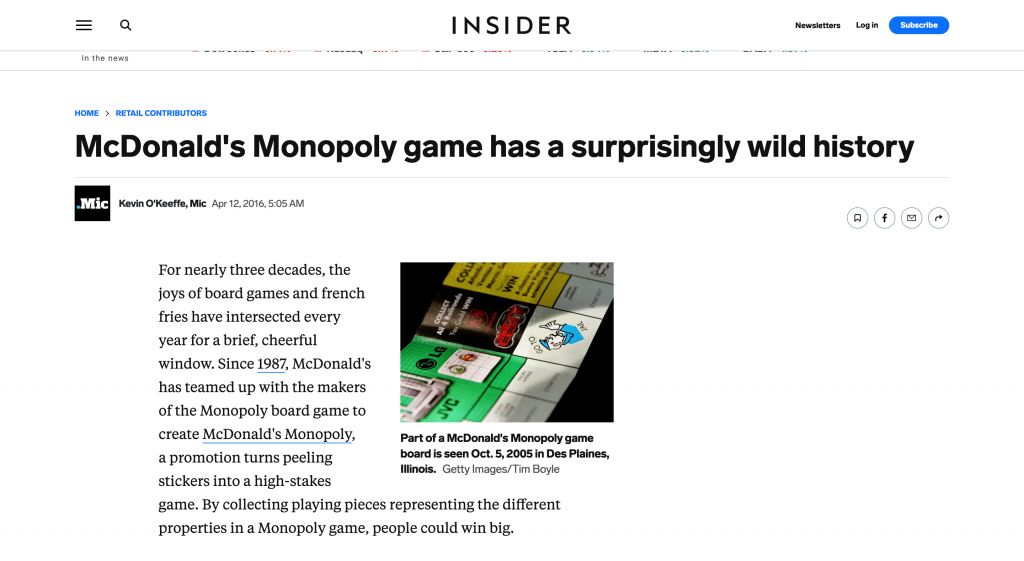
McDonald’s Monopoly sweepstake has been around for a while, and its intent is to encourage people to collect peeling stickers. When they collect enough pieces that represent a specific part of a Monopoly game, they are awarded different prizes.
Although the idea is interesting, as McDonald’s doesn’t directly impose its products on anyone, the company still had some problems with it. Namely, some senators in the U.S. weren’t happy that people were getting promotions for unhealthy food. However, the program still runs to this day, even though it was halted due to the Covid-19 pandemic.
Over to You
Incentive marketing is well worth your time and effort, especially if you’re new to the industry and want to improve brand awareness and get more loyal customers. Of course, not every strategy will suit your business model and marketing strategy, but we’re sure you’ll find something fitting among the examples of incentive marketing campaigns we provided above.
Interested in learning more about other digital marketing strategies? Make sure to check out our blog – we have great informative guides there on a wide variety of topics.

Mariia is a content strategist and editor at Digital Marketer’s World. She is passionate about educating others on all things marketing and believes in the power of the written word.
